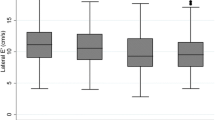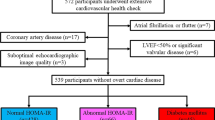Abstract
This study was designed to evaluate the prevalence of cardiometabolic comorbidities and the changes in left ventricular geometry and function in 135 subjects subgrouped according to low or normal total adiponectin plasma (ADPN) levels. Left ventricular (LV) internal diameter/height, total LV mass (LVM) and LVM index (LVMI), relative wall thickness (RWT), LV ejection fraction by echocardiography and diastolic parameters by pulsed-wave Doppler were calculated. Body mass index (BMI) (p < 0.0001), waist-to-hip ratio (p < 0.03), triglycerides (p < 0,001), prevalence of obesity (p < 0.005), visceral obesity (p < 0.003), left ventricular hypertrophy (LVH) (p < 0.001), metabolic syndrome (p < 0.0003) and coronary artery disease (CAD) (p < 0.003) were significantly increased and high-density lipoprotein-cholesterol (p < 0.001) was significantly reduced in hypo-ADPN than normal-ADPN subjects. LVM, LVMI, interventricular septum thickness and RWT were significantly (p < 0.0001) higher and left ventricular ejection fraction was significantly (p < 0.0002) lower in hypo-ADPN than normal-ADPN patients. LVMI correlated directly with BMI (p < 0.001), mean blood pressure (p < 0.001), metabolic syndrome (MetS) (p < 0.001) and inversely with ADPN (p < 0.0001). The prevalence of LVH (p < 0.001) and CAD (p < 0.01) was higher in subjects with normal-ADPN and MetS, while the presence of MetS did not change this finding in hypo ADPN group. Both models of regression analysis indicated that ADPN and BMI resulted independently associated with LVMI. In conclusion, our data seem to indicate that hypoadiponectinemia might be associated with an increased prevalence both of clinical comorbidities and increased LVMI. In this subset of subjects, ADPN and BMI, more than MetS, are able to explain cardiac damage. Accordingly, ADPN might become a new target in the management of cardiometabolic risk.
Similar content being viewed by others
References
Di Chiara T, Argano C, Corrao S et al (2012) Hypoadiponectinemia: a link between visceral obesity and metabolic syndrome. J Nutr Metab ID175245:1–7
Gustafsson S, Lind L, Zethelius B et al (2010) Adiponectin and cardiac geometry and function in elderly: results from two community-based cohort studies. Eur J Endocrinol 162:543–555
Romacho T, Elsen M, Röhrborn D et al (2014) Adipose tissue and its role in organ crosstalk. Acta Physiol (Oxf). doi:10.1111/apha.12246
Nishida M, Funahashi T, Shimomura I (2007) Pathophysiological significance of adiponectin. Med Mol Morphol 40:55–67
Adamczak M, Wiecek A, Funahashi T et al (2003) Decreased plasma adiponectin concentration in patients with essential hypertension. Am J Hypertens 16(1):72–75
Hotta K, Funahashi T, Arita Y et al (2000) Plasma concentrations of a novel, adipose-specific protein, Adiponectin, in type 2 diabetic patients. Arterioscler Thromb Vasc Biol 20:1595–1599
Pischon T, Girman CJ, Hotamisligil GS et al (2004) Plasma adiponectin levels and risk ok of myocardial infarction in men. JAMA 291:134–141
Kojima S, Funahashi T, Maruyoshi H et al (2005) Levels of the adipocyte-derived plasma protein, adiponectin, have a close relationship with atheroma. Thromb Res 115:483–490
Zhang H, Mo X, Hao Y et al (2013) Adiponectin levels and risk of coronary heart disease: a meta-analysis of prospective studies. Am J Med Sci 345(6):455–461
Di Chiara T, Licata A, Argano C et al (2013) Plasma adiponectin: a contributing factor for cardiac changes in visceral obesity-associated hypertension. Blood Press 1–7. doi:10.3109/08037051.2013.823767
Hong SJ, Park CG, Seo HS et al (2004) Associations among plasma adiponectin, hyper-tension, left ventricular diastolic function and left ventricular mass index. Blood Press 13:236–242
Kozakova M, Muscelli E, Flyvbjerg A et al (2008) Adiponectin and left ventricular structure and function in healthy adults. J Clin Endocrinol Metab 93:2811–2818
Mitsuhashi H, Yatsuya H, Tamakowshi K et al (2007) Adiponectin level and left ventricular hypertrophy in Japanese men. Hypertension 49(6):1448–1454
Shibata R, Ouchi N, Ito M et al (2004) Adiponectin-mediated modulation of hypertrophic signals in the heart. Nat Med 10:1384–1389
Katagiri H, Yamada T, Oka Y (2007) Adiposity and cardiovascular disorders: disturbance of the regulatory system consisting of humoral and neuronal signals. Circ Res 101(1):27–39
Wang C, Li L, Zhang ZG et al (2010) Globular adiponectin inhibits angiotensin II- induced nuclear factor kappaB activation through AMP-activated protein kinase in cardiac hypertrophy. J Cell Physiol 222:149–155
Crepaldi G, Belfiore F, Bosello O et al (1991) Special report: Italian Consensus Conference-overweight, obesity and health. Int J Obes 15:781–790
Scaglione R, Ganguzza A, Corrao S et al (1995) Central obesity and hypertension: pathophysiologic role of renal haemodynamics and function. Intern J Obes 19:403–409
American Diabetic Association (2010) Diagnosis and classification of diabetes mellitus. Diabetes Care 33(Suppl 1):S62–S69
Expert Panel on Detection, Evaluation and Treatment of High Blood Cholesterol in Adults (2001) Executive summary of the third report of the national cholesterol program (NCEP-ATP III). JAMA 285(19):2486–2497
Devereux RB, Lutas EM, Casale PN et al (1984) Standardization of M-mode echocardiographic left ventricular anatomic measurements. J Am Coll Cardiol 4:1222–1230
Taylor J (2013) New ESC guidelines published on stable coronary artery disease. Eur Heart J 34(38):2927–2928. doi:10.1093/eurheartj/eht377
Lee Y, Kim BK, Lim YH et al (2013) The relationship between adiponectin and left ventricular mass index varies with the risk of left ventricular hypertrophy. Plos One 8(7):e70246. doi:10.1371/journal.pone.0070246
Pischon T, Hotamisligil GS, Rimm EB (2003) Adiponectin: stability in plasma over 36 hours and within-person variation over 1 year. Clin Chem 49:650–652
Arita Y, Kihara S, Ouchi N et al (1999) Paradoxical decrease of an adipose-specific protein, adiponectin, in obesity. Biochem Biophys Res Commun 257:79–83
Corrao S, Parrinello G, Arnone S et al (1993) Influence of obesity on the echocardiographic evaluation of left ventricular ejection fraction by area-length method: comparison with radionuclide angiography. J Cardiovasc Diagn Proced 11(2):127–134
De Simone G, Devereux RB, Daniels SR et al (1995) Effect of growth on variability of left ventricular mass; assessment of allometric signals in adults and children and their capacity to predict cardiovascular risk. J Am Coll Cardiol 25:1056–1062
Lu JY, Huang KC, Chang LC et al (2008) Adiponectin: a biomarker of obesity-induced insulin resistance in adipose tissue and beyond. J Biomed Sci 15:565–576
Amin RH, Mathews ST, Alli A et al (2010) Endogenously produced adiponectin protects cardiomyocytes from hypertrophy by a PPARgamma-dependent autocrine mechanism. Am J Physiol Heart Circ Physiol 299:H690–H698
Schillaci G, Pirro M, Pucci G et al (2006) Different impact of the metabolic syndrome on left ventricular structure and function in hypertensive men and women. Hypertension 47:881–886
Hao G, Li W, Guo R, Yang JG (2013) Serum total adiponectin level and the risk of cardio-vascular disease in general population. A metaanalysis of 17 prospective studies. Atherosclerosis 228(1):29–35
Zhang H, Mo X, Hao Y, Huang J et al (2012) Adiponectin levels and risk of coronary heart disease: a metaanalysis of prospective studies. Am J Med Sc 345(6):455–461
Kanhai DA, Kranendonk ME, Uiterwaal CS et al (2013) Adiponectin and incident coronary heart disease and stroke. A systematic review and meta-analysis of prospective studies. Obes Rev 14(7):555–567
Guerra F, Mancinelli L, Angelini L et al (2011) The association of left ventricular hypertrophy with metabolic syndrome is dependent on body mass index in hypertensive overweight or obese patients. PLoS One 6(1):e16630. doi:10.1371/journal.pone.0016630
Zhou J, Fu M, Qian J et al (2012) Adiponectin through its biphasic serum level is a useful biomarker during transition from diastolic dysfunction to systolic dysfunction—an experimental study. Lipids Health Dis 11:106
Devereux RB, Roman MJ, de Simone G et al (1997) Relations of left ventricular mass to demographic and haemodynamic variables in American Indians. The Strong Heart Study. Circulation 96:1416–1423
Heckbert SR, Post W, Pearson GD et al (2006) Traditional cardiovascular risk factors in relation to left ventricular mass, volume, and systolic function by cardiac magnetic resonance imaging: the Multiethnic Study of Atherosclerosis. J Am Coll Cardiol 48(11):2285–2292
Ouchi N, Shibata R, Walsh K (2006) Cardioprotection by adiponectin. Trends Cardiovasc Med 16:141–146
Mather KJ, Goldberg RB (2014) Clinical use of adiponectin as a marker of metabolic dysregulation. Best Pract Clin Endocrinol Metab 28:107–117
Acknowledgments
This study was in part supported by a grant of University of Palermo, Italy (2012-ATE-0278).
Conflict of interest
None.
Author information
Authors and Affiliations
Corresponding author
Rights and permissions
About this article
Cite this article
Di Chiara, T., Argano, C., Scaglione, A. et al. Hypoadiponectinemia, cardiometabolic comorbidities and left ventricular hypertrophy. Intern Emerg Med 10, 33–40 (2015). https://doi.org/10.1007/s11739-014-1104-5
Received:
Accepted:
Published:
Issue Date:
DOI: https://doi.org/10.1007/s11739-014-1104-5




